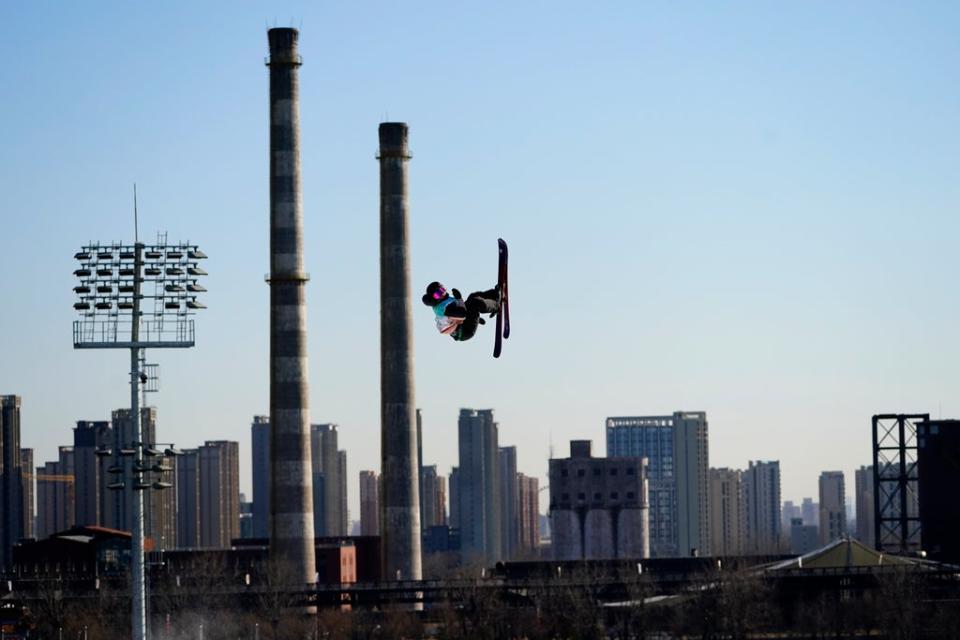The Winter Olympics are taking place in the era of climate collapse – it’s hard to watch

In China, a woman is flying through the air. Over a long arc she flips and spins. As she spirals in a whirl of skis and neatly-held poles she flies past unexpected scenery – towering chimneys, high rise buildings, industrial storage facilities, cooling towers. All around the ground is entirely snow-free. Where’s she going to land?
The camera pulls back and mercifully, a glistening white ribbon of snow appears under her. She touches down, sending up small clouds of artificially-created snow. The crowd applauds.
This bizarre smokestack strewn cityscape with an incongruous ski-ramp at its centre is a somehow apt setting for a Winter Olympics in the climate crisis era: there is no pretence that the skiers are not part of a post-apocalyptic spectacle.
Meanwhile, the downhill skiing is taking place on a purpose-built landscape chiselled out of the cliffs on the edge of a desert.
While here there are fewer industrial elements, it is bizarre in a similarly bleak way: a valley lined with a strip of artificially generated snow and stage-prop pine trees shines bright white against a vast brown desert landscape, barren except for low-level shrubs.
This is because China made its bid for the 2022 Winter Games without an Olympic-standard ski resort, and then embarked upon an almighty three-year project to build one "from scratch", in a place with no previous link to skiing.
The scenery has been planned with a view to reproducing a European Alpine appearance in a kind of disneyfication of the landscape. It has even been suggested the snow-blowers have been turned on the trees to "dress" them for the cameras.
Gone is any deference to natural beauty, gone is the sense of humans enjoying the fragile gifts of nature, and instead, it is a spectacle of force – humanity stamping its designer-brand snowboot on the environment for two weeks of jarring entertainment which really could have been done somewhere else.
Instead of being a celebration of (what’s left of) winter in mountain environments, and an opportunity to remind the world what is still at stake as our emissions continue to rise, the messaging from the 2022 games seems to be that even if we plunder the Earth to death we can still put on a great show while doing so.
Is this the cover of a climate dystopian novel? No? Just the 2022 #OlympicGames? Cool cool cool. pic.twitter.com/ANTXxh9RkI
— Adeline DeYoung (@AdelineDeYoung) February 8, 2022
Every flake of snow the athletes ski, sled and snowboard over at the Beijing Winter Olympics will be artificially created. This is a first. At the previous Pyeongchang Olympics in South Korea, in 2018 it was around 98 per cent of all snow. In Sochi in 2014, around 80 per cent.
The first games where snow machines added to the snow already on the slopes was only in 1980 in Lake Placid, New York.
The 2022 games are using almost 400 snow guns, and China has reportedly estimated the snow cannons will require 49 million gallons of water, though some experts have suggested this is a significant underestimate for the amount needed.
It feels as though the next Olympics could take place anywhere if enough money was thrown at it. Why not a huge Truman-show style dome in the middle of a desert, with fake mountains, fake snow and projections of beautiful Alpine villages around the walls?

As it happens the next Winter Olympics is returning to the Alps in 2026, in Cortina d’Ampezzo and Milan in Italy.
But such is the speed of the climate crisis, the location is no guarantee that it will avoid the environment-modifying techniques showcased by China this year.
Since the Olympics were last held in Cortina in 1956, the 70 years in between will have seen an average temperature increase of 3.2C (5.9F).
Of the 21 venues used for the Winter Games since the French resort of Chamonix hosted the first in 1924, researchers estimate that, by 2050, only 10 will have the "climate suitability" and natural snowfall levels to host an event.
These stats are the grim outcome of a collective failure to halt emissions of the climate-altering gases we already have the technology to stop extracting and burning.
Winter athletes not only ought to be quaking in their boots, but leading the calls for action.

